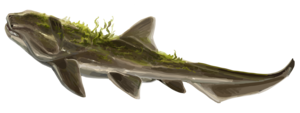Heterosteus
| Heterosteus Temporal range: Middle Devonian: Givetian,
| |
|---|---|

| |
| Life reconstruction of Heterosteus ingens | |
| Scientific classification | |
| Kingdom: | Animalia |
| Phylum: | Chordata |
| Class: | †Placodermi |
| Order: | †Arthrodira |
| Suborder: | †Brachythoraci |
| Clade: | †Eubrachythoraci |
| Clade: | †Pachyosteomorphi |
| Superfamily: | †Dunkleosteoidea |
| Family: | †Heterosteidae |
| Genus: | †Heterosteus Asmuss, 1856 |
| Species | |
| Synonyms | |
| |
Heterosteus (also known as Heterostius[1][2]) is an extinct genus of heterosteid placoderm of the Middle Devonian known from remains discovered in Europe and Greenland.
Name
Heterosteus was originally described in 1837 as species of Trionyx, a softshelled turtle.[3] Also in later studies it was often misidentified and given names like Ichthyosauroides, Asterolepis asmussi and Chelonichthys asmusii.[1] Even in recent studies, it is controversial as to whether to use genus name Heterosteus or Heterostius. According to International Code of Zoological Nomenclature, suffix ‘-ostius’ in scientific name should not be corrected as ‘-osteus’, so some study uses genus name Heterostius.[1]
Description
This genus includes the largest species in the family, and are among the largest arthrodires, as well, with the type species, H. asmussi, having an estimated body length of up to 6 metres (19 ft 8 in).[4] The genus differs from Herasmius by having the orbits on slightly longer eyestalk-like projections. The various species are found in Givetian-aged deposits in Europe and Greenland. With the except of the German H. rhenanus, all species are known from freshwater deposits: H. rhenanus is based on fragments found in a marine deposit.
Phylogeny
Heterosteus is the type genus for the family Heterosteidae, which belongs to the superfamily Dunkleosteoidea. It is a relative of the giant Dunkleosteus, as shown in the cladogram below:[1]
| Dunkleosteoidea |
| ||||||||||||||||||||||||||||||||||||||||||||||||||||||
References
- ^ a b c d Zhu, You-An; Zhu, Min; Wang, Jun-Qing (1 April 2016). "Redescription of Yinostius major (Arthrodira: Heterostiidae) from the Lower Devonian of China, and the interrelationships of Brachythoraci". Zoological Journal of the Linnean Society. 176 (4): 806–834. doi:10.1111/zoj.12356. ISSN 0024-4082.
- ^ Schultze, Hans-Peter; Cumbaa, Stephen L. (26 April 2017). "A new Early Devonian (Emsian) arthrodire from the Northwest Territories, Canada, and its significance for paleogeographic reconstruction". Canadian Journal of Earth Sciences. 54 (5): 461–476. Bibcode:2017CaJES..54..461S. doi:10.1139/cjes-2017-0013. hdl:1807/76893.
- ^ Woodward, Arthur Smith (1891). Catalogue of the fossil fishes in the British Museum (Natural History). Vol. 2. London: Printed by order of the Trustees.
- ^ Denison, Robert (1978). Placodermi Volume 2 of Handbook of Paleoichthyology. Stuttgart New York: Gustav Fischer Verlag. p. 66. ISBN 978-0-89574-027-4.
Error: "Q3785387" is not a valid Wikidata entity ID.
Error: "Q112325922" is not a valid Wikidata entity ID.
- Articles with 'species' microformats
- Taxonbars desynced from Wikidata
- Taxonbar pages requiring a Wikidata item
- Taxonbars with invalid from parameters
- Taxonbars with multiple manual Wikidata items
- Taxonbars without secondary Wikidata taxon IDs
- Arthrodires
- Placoderm families
- Middle Devonian first appearances
- Middle Devonian extinctions
- Fossil taxa described in 1844
- Fossil taxa described in 1856








